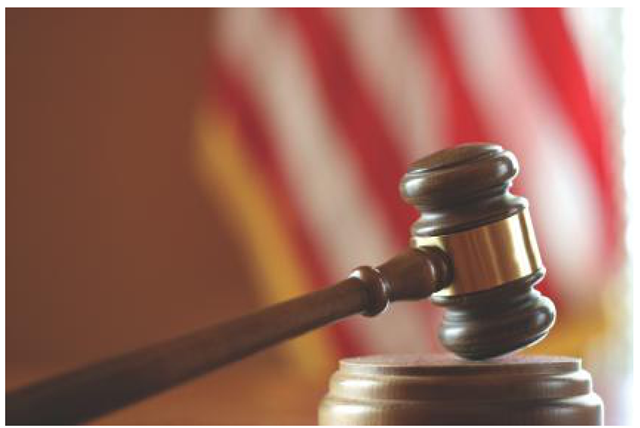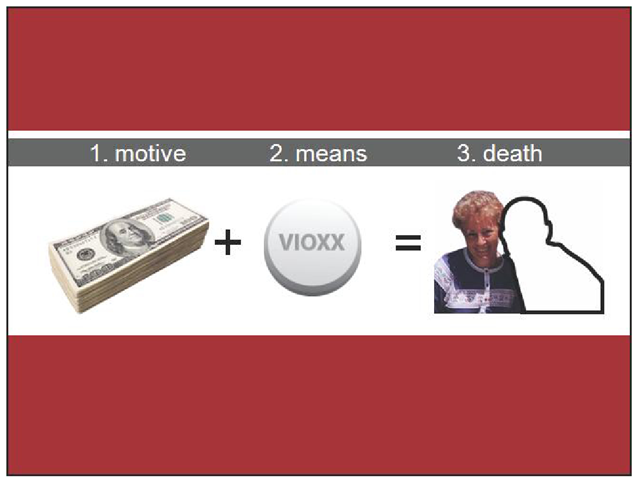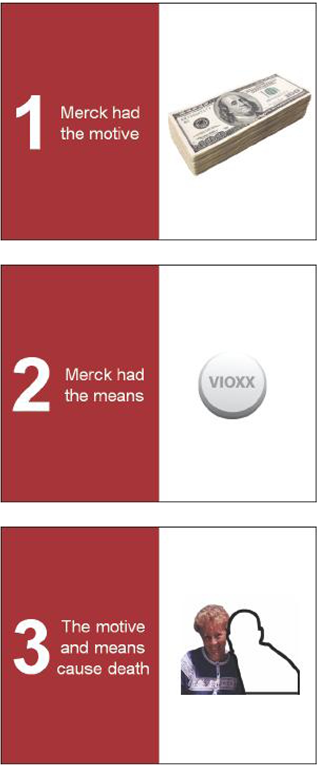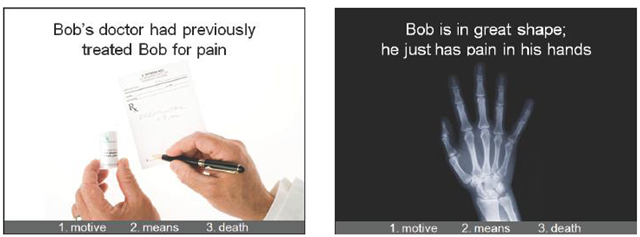The Heart of the Problem
Mark clicked the remote control to advance to the next slide, showing an image of a headquarters building, similar to Figure 1-8, as he said, "The evidence is going to lead you to one place"—the front steps of one of the largest pharmaceutical companies in the world. Mark explained that he would show a great deal of evidence from many sources that all proved the company’s drug was a cause of Bob’s heart attack. But then he added, "There are lots of different ways it can be painted," and jurors would have to eventually weigh the evidence against everything else they would hear.
FIGURE 1-8 Next Mark showed a photo of the headquarters building of the pharmaceutical company, similar to this, and told jurors that the evidence in the case would lead to the company’s doorstep.
Mark clicked the remote button to show the next slide, a photograph of a gavel and flag, similar to Figure 1-9, as he said, "You’re going to hear all of this evidence because… your job to do is to get us to justice…Nobody else has this power. A judge can’t do it… Politicians can’t do it. Nobody else can do it. This is where you can make a difference in the world."
The image of the gavel along with Mark’s narration reinforced the problem the jurors faced: they will see the evidence against the company, and they will have to sort through it and bring the situation to justice.
FIGURE 1-9 With a gavel and flag displayed on screen, Mark explained that the jurors could bring the situation to justice.
Next, as Mark began to click to a slide similar to the one shown in Figure 1-10, he said, "How are you going to do it? My suggestion to you is, again, you’ve got to follow the evidence. First of all, I’m going to show you a motive." The word motive appeared on the screen (left) along with a picture of a stack of money. "I’m going to show you the means," he said, as the word means and an image of pills similar to this one appeared on the screen (middle). "I’m going to show you the death," he said, as the word death and the familiar outline of Bob appeared next to Carol on the screen (right).
FIGURE 1-10 This summary slide visually distills the entire case into a single image. The horizontal bars above and below the icons are red to indicate that this slide stands out as the most important in the presentation.
With these slides, Mark asked the jurors to follow the simple formula that underlies every murder-mystery story: motive + means = death. Even jurors who don’t watch TV would know this familiar structure from topics, board games, or stories in the news. Earlier, Mark hinted at a murder-mystery motif with the black outline and again with the CSI reference, and now at the most important part of the presentation, he fully established the murder-mystery motif as the structure for the entire presentation to come.
Although the slide appears simple, it is extremely sophisticated in its effect because it reduces a complex case into something easy to understand and follow.
Distilling the Essence
As he was in the planning stage of his presentation, Mark faced a vast amount of information that he could potentially present to his audience, as you certainly do in your own presentations. For Mark, it would be tough to explain the complex science behind how the drug worked, how it was developed, and how it was reviewed and studied. It would be confusing to recount the details of every event, every person involved, and the sequence in which the case unfolded. It was a daunting task to select the most important evidence to explain the case from more than 3 million documents and countless hours of videotaped depositions from witnesses.
On top of the vast amount of information to choose from, Mark faced the constraints of a limited amount of time to communicate to his audience, just as you do in your presentations. In no more than two and a half hours, he had to present the jurors with an overview of the case, educate them about key concepts, and equip them with a framework to understand the six weeks of testimony to come. And he had to do all this while keeping jurors interested and engaged.
"Planning the Rest of Your Slides," Mark solved the problem of potentially overwhelming his audience by distilling his presentation into three roughly equal parts that he would spend equal amounts of time explaining. With his three key points identified, and using the murder-mystery motif as a familiar structure, Mark verbally and visually introduced the enormously complex case to jurors as being "as easy as 1-2-3" to understand, using this summary slide as he spoke.
Next Mark clicked the remote to show the slides containing his key points, similar to the images shown in Figure 1-11, as he introduced each of the three sections of the presentation. Instead of overwhelming jurors with 3 million documents, Mark now guided them along what appeared to be a very simple story as he introduced the three most important parts of the case, which he then explained in more detail as his presentation moved forward. Now the jurors could relax as they listened and watched the story unfold.
In any presentation, the audience can’t possibly remember all the information they see and hear, but it helps if you give them graphical cues to the presentation’s organization and the slides’ relative importance. The look of these three slides was based on the style of the earlier summary slide, carrying forward the story visually to complement Mark’s verbal explanation. The simple split-screen layout of the slides, the use of the striking red color, and the consistent graphical style ensured that when these slides appeared, they would stand out as the most important among all of the slides.
FIGURE 1-11 As he introduced each of the three sections of the opening statement, Mark displayed slides that carried forward the theme from the earlier summary slide, including the red backgrounds on the left half of each slide.
Mixing Mediums
With this simple yet clear and engaging introduction to his opening statement, Mark had succeeded in presenting a framework that would be easy for jurors to follow. He continued to integrate the story seamlessly through the remaining slides over the next couple of hours. Although your own presentations will likely not last as long, the same
BBP approach will give you the ability to quickly scale down any presentation from 45 minutes to 15 to 5.
As Mark continued through the presentation, many slides in the presentation looked similar to the ones shown in Figure 1-12. The slides were designed so that the jurors’ attention would first go to the most important information at the top of the screen—a headline that summarized the main point at hand, like a newspaper headline. Next the jurors would see a simple graphic that illustrated the specific headline. Last the jurors’ attention would shift from the screen to Mark, who explained the point of the slide in more detail. The range of visuals used on the slides included a wide variety of photographs, medical illustrations, documents, screen captures, timelines, and more.
FIGURE 1-12 The slides within each section of the presentation used a similar layout style, which helped the jurors quickly understand the information.
Mark clicked through the 153 slides of this presentation at a pace of less than one minute per slide, which allowed his audience to digest the information on the screen before moving forward to the next slide and the next part of the story. This pace kept the jurors visually interested.
Conventional PowerPoint slides can overwhelm audiences with too much information on the screen, but Mark’s presentation contained only one idea per slide, giving jurors time to digest each point as they listened to Mark’s verbal explanation. Instead of reading bullet points from the screen, Mark used his slides as visual cues to prompt him on the next point he would make, allowing him to speak with a natural and spontaneous style that came from the depth of his knowledge and authority on his topic. And instead of looking at the screen to see what was on it, Mark kept his attention focused on the jurors, making eye contact with each person throughout the presentation.
Beyond the PowerPoint slides, Mark also used a range of other media and physical props to engage with the audience over the course of the presentation. At times, he switched the screen to a document projector, where he displayed physical paper documents and highlighted passages on the pages with a yellow marker as he explained the significance of the evidence. Later he used a large paper flip chart that he calls a "double-wide," where he wrote out key terms and concepts with large markers. Sometimes he switched from the slides to a brief video that illustrated a point. Other times, he used physical props such as a plastic model of a heart held up in his hand to teach jurors the science behind heart attacks.
Mark used different types of media to keep things varied and interesting throughout the presentation and to keep the experience from feeling too slick and produced. But after using each type of media, Mark always returned to the PowerPoint presentation on the 10-foot screen because it was a visually unifying tool he could use to move the story forward. The shifting and dissolving images holding the audience’s interest on the large screen seamlessly came together with Mark’s physical presence, and his voice filled in key details while remaining consistent with the visual presentation. In the Angleton courtroom, PowerPoint had taken on a new role—it was now a tremendously persuasive backdrop that would have a major impact on the jurors in the eye of the PowerPoint storm in this Angleton courtroom.
Fade to Gray
After Mark finished his presentation, the judge allowed a break, and the jurors left the courtroom. Now it was the defense team’s turn to present its opening statement. They got their PowerPoint presentation ready on their own laptop computer, and they rolled back the podium to where it had been before Mark moved it, in front of the jury box. When the jurors returned, the defense lawyer walked up to the podium, looked down at his printed notes, and began to read his opening statement to the jurors.
In the crucial first few minutes of the presentation, when it is essential to make an audience feel like the presentation is all about them, the lawyer recited the details about the admirable history of the company. Instead of making the presentation human by telling an anecdote about a real person, he cited dry data about the millions of people the company aims to reach with its various drugs. As he read the prepared script in formal and impersonal language, someone else on his team advanced the PowerPoint slides forward on the computer, sometimes missing a cue and leaving a disconnect between what the lawyer said and what the jurors saw on the screen. The lawyer occasionally turned back to look at the screen behind him to point at a complicated chart or a long passage of text.
Rather than display a dynamic and engaging visual experience, the lawyer next showed a slide with a formal photograph of the company’s former CEO in a coat and tie as he talked about the CEO and his family, his biography, his public service, and his civic involvement. Missing the chance to connect with the everyday people in the jury with color and character, the defense lawyer continued on with slides that showed formal photographs of other corporate executives, and he talked about their Ivy League educations, detailed biographies, and long lists of accomplishments. Missing the point that less is more, later the lawyer displayed the familiar bullet points, charts, and long passages of text that the jurors strained to read.
The defense lawyer’s relationship with the jurors never warmed up with the chilly and formal tone of the prepared talk. The podium that was now in front of the jurors had erected a wall between the presenter and his audience, the prepared script took away the lawyer’s natural voice and spontaneity, and the PowerPoint slides on the screen became a 10-foot distraction from the lawyer who was speaking.
At the end of the defense’s presentation, everyone stood as the jurors left the courtroom, and then the court adjourned for the day. If what lawyers believe is true, the two presentations the jurors had just experienced would play a significant role in the verdict they would reach at the end of the trial. Whatever the jurors thought that day, the journalists in the room wasted no time in pronouncing their verdict about how they thought the two PowerPoint presentations had gone.
Stark Choices
The news media cover opening statements of legal trials every day, but it’s unusual when the topic of the coverage is the presentation style itself. According to the coverage of this opening statement the next day, something exceptional had happened in the Angleton courtroom. According to Fortune’s account, Mark "gave a frighteningly powerful and skillful opening statement," speaking "without notes and in gloriously plain English" and taking on the defendant "with merciless, spellbinding savagery" (Roger Parloff, "Stark Choices at the First Vioxx Trial," Fortune, July 15, 2005). The reporter had not noticed that Mark did have a form of notes—his PowerPoint presentation in Presenter view on his laptop below the jury box. The New York Times reported that in comparison with Mark’s opening, the defense lawyer’s presentation was "staid" and that "he read portions of his statement and illustrated his talk mostly using blue-and-yellow PowerPoint pie charts and long excerpts of letters from the Food and Drug Administration" (Alex Berenson, "Contrary Tales of Vioxx Role in Texan’s Death," New York Times, July 15, 2005).
According to Fortune: "The trial offers jurors a stark choice between accepting Lanier’s invitation to believe simple, alluring and emotionally cathartic stories" and the defense’s "appeals to colorless, heavy-going soporific Reason. Lanier is inviting the jurors to join him on a bracing mission to catch a wrongdoer and bring him to justice." In contrast, the Fortune article continued, the defense "is asking the jurors to do something difficult and unpleasant like—well—taking medicine."
Six weeks later, the trial ended, and the jurors entered the jury room to deliberate. After a day and a half of discussion, the jurors made a decision, and the journalists and lawyers filled the courtroom again to hear what they would say. The jurors awarded the plaintiff a stunning $253 million verdict. Amid the storm of international headline news, the pharmaceutical company’s market capitalization fell $5 billion (Alex Berenson, "Jury Calls Merck Liable in Death of Man on Vioxx," New York Times, August 20, 2005).
After the verdict was announced, the Wall Street Journal reported one juror as saying "’Whenever [the defense] was up there, it was like wah, wah, wah,’ . . . imitating the sounds Charlie Brown’s teacher makes in the television cartoon. ‘We didn’t know what the heck they were talking about’" (Heather Won Tesoriero, "Merck Loss Jolts Drug Giant, Industry," Wall Street Journal, August 22, 2005).
The impact of the PowerPoint presentation in Mark’s opening statement proved to last long after the trial. Six months later, Mark met with the Angleton jurors during a focus group session to see what they remembered about the trial, and the jurors vividly recalled the specific story and images that Mark presented in his opening statement.
Winds of Change
Although using PowerPoint helped win the day in Angleton for the plaintiff, that particular story did not end there, as many more Vioxx cases went to trial in other courtrooms around the U.S. Later the pharmaceutical company’s market capitalization recovered, and Merck agreed to settle all Vioxx claims in 2007 with a $4.85 billion settlement fund. But what was unlocked in Angleton that July day was an example of the dramatic results an effective PowerPoint approach can have on a single presentation in a single room with a single audience.
The BBP approach had never been used in a courtroom before the Angleton trial, but since that day, its impact is still reverberating through the legal profession. Today, if a legal team faces a courtroom opponent who is using BBP, they know that they have to somehow respond and raise the bar of their own presentations. Legal teams that have faced opponents using BBP in the courtroom have started to adopt the story themes and graphics that the other side uses. For example, in trials against the pharmaceutical company that followed the Angleton verdict, the defense lawyers began using the "CSI" theme in their presentations. When Mark faced them again, he used techniques to counter what the defense lawyers did, raising the bar even higher.
The same sorts of impacts are being felt in other professions as well, as BBP begins to transform the status quo for presenters everywhere. As you consider applying BBP to your own presentations in this topic, it might seem hard to imagine how to apply these types of techniques to your specific profession. But beyond lawyers and law firms, many people in many other professions and organizations are accomplishing significant results with this approach, including presenters in major corporations, governmental agencies, universities, research firms, and nonprofit organizations. Within these groups, people use BBP in a wide range of functions such as marketing, sales, training, and education.
In this topic, you’ll find examples of presentations from different fields and for different purposes so that you see how to apply BBP to your own situation.
Everything Mark and many others have accomplished using the BBP approach is explained in detail in this topic.You’ll get advice on delivering BBP presentations."Delivering Your BBP Presentation," and you’ll see how BBP plays out through a wide range of presentation contexts and purposes.The companion Web site to this topic, at www.beyondbulletpoints.com, offers advanced resources to the fast-growing community of people using BBP. By the end of this topic, you should be well equipped with the knowledge and tools you need to start applying BBP to your own presentations.
The Power of BBP in Your Hands
Mark’s presentation in Angleton is only a sample of how to use BBP to unlock the engaging, compelling stories inside of you. When Mark entered the Angleton courtroom that hot July day to present his opening statement, he had the same PowerPoint software you have. He just used it in an innovative way that produced dramatic results and made headline news. The topic in your hands right now gives you the power to do the same.





